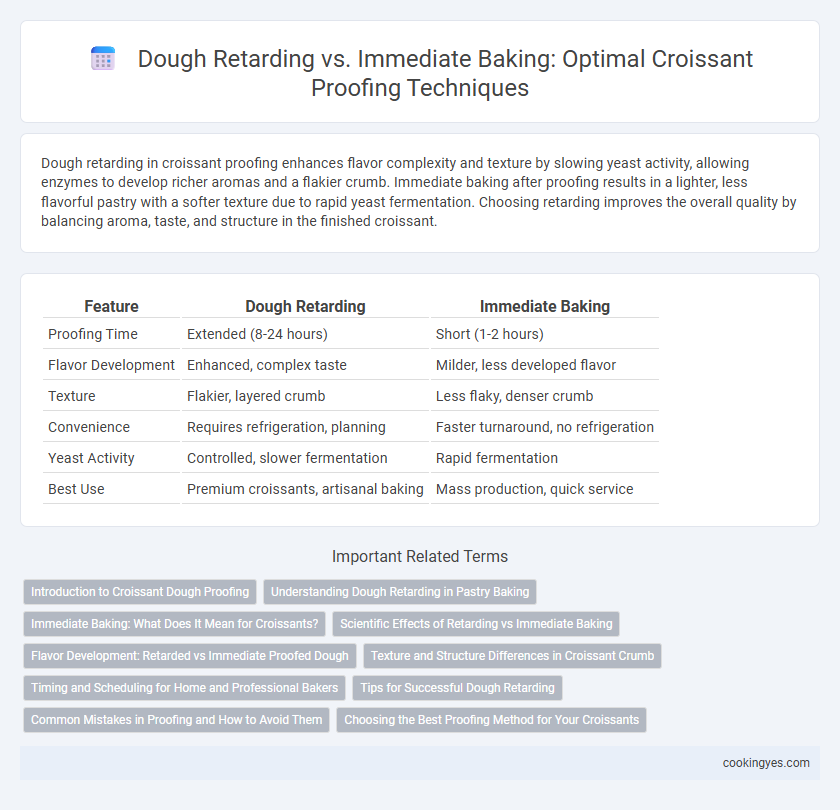Dough retarding in croissant proofing enhances flavor complexity and texture by slowing yeast activity, allowing enzymes to develop richer aromas and a flakier crumb. Immediate baking after proofing results in a lighter, less flavorful pastry with a softer texture due to rapid yeast fermentation. Choosing retarding improves the overall quality by balancing aroma, taste, and structure in the finished croissant.
Table of Comparison
| Feature | Dough Retarding | Immediate Baking |
|---|---|---|
| Proofing Time | Extended (8-24 hours) | Short (1-2 hours) |
| Flavor Development | Enhanced, complex taste | Milder, less developed flavor |
| Texture | Flakier, layered crumb | Less flaky, denser crumb |
| Convenience | Requires refrigeration, planning | Faster turnaround, no refrigeration |
| Yeast Activity | Controlled, slower fermentation | Rapid fermentation |
| Best Use | Premium croissants, artisanal baking | Mass production, quick service |
Introduction to Croissant Dough Proofing
Croissant dough proofing involves controlling yeast activity to develop optimal texture and flavor. Dough retarding, achieved by refrigeration, slows fermentation, allowing complex flavor compounds to form and improving dough extensibility for flakier layers. Immediate baking accelerates proofing, producing a softer crumb but less nuanced taste compared to retarded dough.
Understanding Dough Retarding in Pastry Baking
Dough retarding in croissant proofing involves refrigerating the dough to slow yeast activity, enhancing flavor development and improving the lamination structure critical for flaky layers. This controlled fermentation allows gluten relaxation and intensifies complex flavors, contrasting with immediate baking, where faster proofing results in a milder taste and less defined layers. Retarding dough not only improves texture and taste but also provides flexibility in production scheduling for pastry bakers.
Immediate Baking: What Does It Mean for Croissants?
Immediate baking for croissants means proofing the dough at room temperature without refrigeration, which accelerates yeast activity, resulting in a faster rise. This method produces croissants with a lighter texture and a more pronounced oven spring but may sacrifice some complexity in flavor compared to retarded dough. Bakers choosing immediate baking prioritize speed and volume while achieving the classic flaky layers associated with traditional croissants.
Scientific Effects of Retarding vs Immediate Baking
Retarding croissant dough through cold fermentation slows yeast activity, enhancing flavor complexity by allowing enzymatic reactions to develop organic acids and volatile compounds. Immediate baking after proofing results in faster fermentation but offers less time for flavor maturation and improved texture formation. Scientific studies show that retarding improves dough extensibility and lamination quality, leading to a flakier, more aromatic croissant compared to immediate baking methods.
Flavor Development: Retarded vs Immediate Proofed Dough
Retarded dough proofing for croissants enhances flavor development by allowing extended fermentation, which promotes complex organic acid production and deeper yeast activity, resulting in richer taste profiles. Immediate baking after proofing yields a lighter, more neutral flavor as the shorter fermentation limits the biochemical reactions that contribute to aromatic compound formation. The choice between retarding and immediate proof influences not only texture but significantly affects the nuanced flavors, with retarding preferred for artisanal, robust croissants.
Texture and Structure Differences in Croissant Crumb
Dough retarding in croissant proofing enhances the development of a more complex crumb structure, resulting in a flakier texture due to slower yeast fermentation and extended enzymatic activity. Immediate baking after proofing yields a denser crumb with less pronounced layering, as rapid fermentation limits gluten network development and gas retention. Retarded dough typically produces a crisper crust and a more aerated, tender interior, essential for premium croissant quality.
Timing and Scheduling for Home and Professional Bakers
Dough retarding for croissant proofing involves refrigerating the dough for 12 to 24 hours, which slows yeast activity and enhances flavor development while providing flexibility in timing and scheduling for both home and professional bakers. Immediate baking requires proofing the dough at room temperature for 1 to 3 hours, demanding precise timing and often limiting baking to a single continuous session. Retarding dough allows bakeries to stagger production and maintain a consistent quality, while home bakers benefit from accommodating baking schedules around daily routines.
Tips for Successful Dough Retarding
Dough retarding for croissant proofing enhances flavor complexity and improves texture by slowing yeast activity during fermentation. Store the shaped croissants in the refrigerator at 4degC (39degF) for 12 to 24 hours to allow gradual proofing and optimal butter lamination. Ensure proper dough hydration and avoid overproofing by monitoring dough expansion to achieve flaky, tender layers upon baking.
Common Mistakes in Proofing and How to Avoid Them
Overproofing croissant dough leads to a weak gluten structure, causing collapse during baking, while underproofing results in dense layers and insufficient rise. Common mistakes include proofing at too high a temperature, which accelerates fermentation and reduces flavor development, and neglecting dough retarding, which enhances dough strength and improves lamination. To avoid these errors, maintain proofing temperatures around 24degC (75degF), use cold retardation in refrigeration for 12-16 hours, and monitor dough elasticity to ensure optimal yeast activity and layered texture.
Choosing the Best Proofing Method for Your Croissants
Choosing the best proofing method for croissants involves understanding the impact of dough retarding versus immediate baking on texture and flavor. Dough retarding, which involves cold fermentation in a refrigerator for 12-24 hours, enhances the development of complex flavors and results in a flakier, layered crumb. Immediate baking after proofing speeds up the process but can lead to less flavorful, denser croissants with less caramelization of the butter layers.
Dough retarding vs immediate baking for croissant proofing Infographic

 cookingyes.com
cookingyes.com